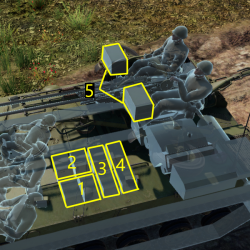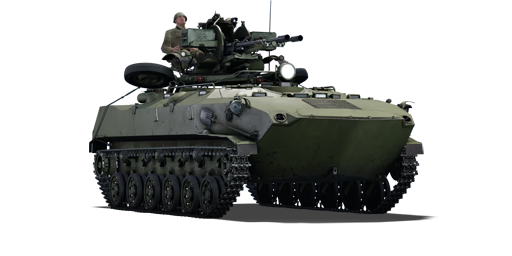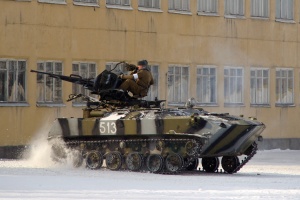Difference between revisions of "BTR-ZD"
(→Pros and cons) (Tag: Visual edit) |
Colok76286 (talk | contribs) (Edits) |
||
| Line 163: | Line 163: | ||
'''Pros:''' | '''Pros:''' | ||
| − | * Very high fire | + | * Very high rate of fire, easy to intercept fast targets |
| − | * All ammo types have enough penetration for most light and medium tanks, like [[M24 (Family)|M24]], [[Sd.Kfz.234 | + | * All ammo types have enough penetration for most light and medium tanks, like [[M24 (Family)|M24]], [[Sd.Kfz.234 (Family)|Sd.Kfz.234]] |
* Night vision capabilities | * Night vision capabilities | ||
* Amphibious | * Amphibious | ||
| Line 172: | Line 172: | ||
'''Cons:''' | '''Cons:''' | ||
| − | * Low survivability: thin armour on the hull and exposed gunner | + | * Low survivability: thin armour on the hull and exposed gunner and loader |
| − | * Can be pierced by 12.7 mm machine guns and larger weapons | + | * Can be pierced by 12.7 mm machine guns and larger-calibre weapons |
* Guns overheat fast if not fired in bursts | * Guns overheat fast if not fired in bursts | ||
* Slow -6 km/h reverse speed | * Slow -6 km/h reverse speed | ||
| Line 202: | Line 202: | ||
* ''other literature.'' --> | * ''other literature.'' --> | ||
| − | * http://www.military-today.com/artillery/btr_zd.htm | + | * [[wikipedia:BTR-D#Variants|[Wikipedia] BTR-D - Variants]] |
| − | + | * [http://www.military-today.com/artillery/btr_zd.htm <nowiki>[Military Today]</nowiki> BTR ZD] | |
| − | * https://weaponsystems.net/system/64-BTR-ZD%20%22Skrezhet%22 | + | * [https://weaponsystems.net/system/64-BTR-ZD%20%22Skrezhet%22 <nowiki>[Weapon Systems]</nowiki> BTR-ZD "Skrezhet"] |
{{USSR anti-aircraft vehicles}} | {{USSR anti-aircraft vehicles}} | ||
Revision as of 15:34, 27 June 2022
Contents
Description
The BTR-ZD is a rank IV Soviet SPAA with a battle rating of 5.7 (AB) and 6.0 (RB/SB). It was introduced in Update "Danger Zone".
Based on the BTR-D chassis derived from VDV's BMD-1, the BTR-ZD offers devastating twin 23 mm autocannons with good accuracy and rate of fire, as well as being mobile; while having the bare minimal survivability for the crew.
General info
Survivability and armour
The BTR-D APC chassis was derived from BMD-1, an airborne IFV of the VDV, designed to be paradropped by transporter aircraft; thus one of its requirements was being light, the extensive use of ABT-101 aluminium alloy ensured its structural integrity while providing a bare minimum of protection for the crew.
With the maximum thickness of the armour being 32 mm on the front and two crew members completely exposed, almost anything can take you out. The speed of the vehicle acts as a substitute to the low armour. If the vehicle is shot from the side by an AP round it likely won't do much damage and won't hit the ammo but an HE round will almost certainly take out at least 2 crew members. The spacing of the crew members is disadvantageous as they are all close together and 1 good shot might be able to take them all out.
Armour type:
- Alloy ABT-101
| Armour | Front (Slope angle) | Sides | Rear | Roof |
|---|---|---|---|---|
| Hull | 23 mm (63°) Top 15 mm (73°) UFP 32 mm (48°) LFP |
23 mm Top 20 mm Bottom |
20 mm Bottom | 12 mm |
Notes:
- Suspension wheels are 10 mm thick, tracks are 15 mm thick
Mobility
Thanks to the light weight of the vehicle, its 5D-20 V6 engine can output up to 241 hp and pushes the BTR-ZD to 61 km/h, comparable to its Chinese counterpart ZSD63; it also has high power-weight ratio. While having sufficient forward speed, it can only go 6 km/h in reverse, so beware of being over-extended.
| Game Mode | Max Speed (km/h) | Weight (tons) | Engine power (horsepower) | Power-to-weight ratio (hp/ton) | |||
|---|---|---|---|---|---|---|---|
| Forward | Reverse | Stock | Upgraded | Stock | Upgraded | ||
| Arcade | 67 | 7 | 9 | 341 | 458 | 37.89 | 50.89 |
| Realistic | 62 | 7 | 212 | 240 | 23.56 | 26.67 | |
Modifications and economy
Armaments
Main armament
The ZU-23 is perhaps one of the most famous AA autocannon in service, due to the lack of anti-air capabilities of VDV troops in the early stages of being air-dropped. The BTR-ZD straps a ZU-23-2 mount onto the top of the chassis, which has high rate of fire and sufficient penetration to tear down most targets it might see on their sides. Note that it takes a relatively long time to reload its guns, so be sure to make every shot count.
| 23 mm ZU-23 (x2) | Turret rotation speed (°/s) | Reloading rate (seconds) | ||||||||||||
|---|---|---|---|---|---|---|---|---|---|---|---|---|---|---|
| Mode | Capacity (Belt) | Fire rate | Vertical | Horizontal | Stabilizer | Stock | Upgraded | Full | Expert | Aced | Stock | Full | Expert | Aced |
| Arcade | 500 (50) | 800 | -10°/+90° | ±180° | N/A | 52.8 | 73.1 | 88.8 | 98.2 | 104.5 | 13.00 | 11.50 | 10.60 | 10.00 |
| Realistic | 35.7 | 42.0 | 51.0 | 56.4 | 60.0 | |||||||||
Ammunition
- Default: API-T · HEF-I
- HEI-T: HEF-I · HEFI-T · HEF-I · API-T
- API-T: API-T · API-T · API-T · HEFI-T
| Penetration statistics | ||||||
|---|---|---|---|---|---|---|
| Belt | Penetration @ 0° Angle of Attack (mm) | |||||
| 10 m | 100 m | 500 m | 1,000 m | 1,500 m | 2,000 m | |
| Default | 51 | 48 | 36 | 26 | 18 | 13 |
| HEI-T | 51 | 48 | 36 | 26 | 18 | 13 |
| API-T | 51 | 48 | 36 | 26 | 18 | 13 |
| Shell details | |||||||||
|---|---|---|---|---|---|---|---|---|---|
| Ammunition | Type of warhead |
Velocity (m/s) |
Projectile mass (kg) |
Fuse delay (m) |
Fuse sensitivity (mm) |
Explosive mass (TNT equivalent) (g) |
Ricochet | ||
| 0% | 50% | 100% | |||||||
| 23 mm HEF-I | HEF-I | 980 | 0.18 | 0 | 0.1 | 28.49 | 79° | 80° | 81° |
| 23 mm API-T | API-T | 970 | 0.19 | N/A | N/A | N/A | 47° | 60° | 65° |
| 23 mm HEFI-T | HEFI-T | 970 | 0.19 | 0 | 0.1 | 20.02 | 79° | 80° | 81° |
Ammo racks

| Full ammo |
1st rack empty |
2nd rack empty |
3rd rack empty |
4th rack empty |
5th rack empty |
Visual discrepancy |
|---|---|---|---|---|---|---|
| 10 | 8 (+2) | 6 (+4) | 4 (+6) | 2 (+8) | 0 (+10) | Yes |
Machine guns
An unusual feature of BTR-ZD is having a pair of hull machine guns (not modelled in X-ray view); although being practically useless any against armoured targets, they could still be used to gun down exposed crews in rare cases.
| 7.62 mm PKT | ||||
|---|---|---|---|---|
| Mount | Capacity (Belt) | Fire rate | Vertical | Horizontal |
| Hull | 500 (250) | 700 | ±2° | ±3° |
| Hull | 500 (250) | 700 | ±2° | ±3° |
Usage in battles
Due to being made out of ABT-101 aluminium alloy and the thickest area of the armour being 32 mm at the front of the vehicle, a head on engagement with a ground vehicle is not recommended, especially against vehicles with high-calibre machine guns or autocannons. If used against ground targets, make good use of the BTR-ZD's high mobility and flank the enemies to avoid being immediately sent back to the hangar. Most HE rounds will decimate the vehicle right away, even if it somehow survives the hit, the exposed crew will not have a good day. When facing heavier targets (such as Churchills), chances are the autocannons onboard with relatively low penetration will be practically useless against any WWII heavy tanks, so either disable their tracks or just avoid them at all costs. When encountering vehicles with strong frontal armour but weak side armour (such as the Hetzer) try to flank and take them out by shooting at their sides.
When engaging air targets, try to take out the target before it shoots back, because if it does the gunner and loader will almost certainly be rendered unconscious and will leave you vulnerable to follow up attacks. Since the vehicle is amphibious, a strategy that can be used on maps with rivers and bridges (in maps like European Province) is to peek out under the bridge to fire, then hide in the bridge arches to reload, or make good use of the waterways to sneak up on the enemies and deliver a surprise attack. As with any SPAA, it is also suggested to stay close to cover to avoid gun strafing, bombs, and rockets. Lastly it is advised to stay near trees so that you can quickly go behind them and make it harder to spot you while you are reloading, or use your mobility to quickly change positions.
Pros and cons
Pros:
- Very high rate of fire, easy to intercept fast targets
- All ammo types have enough penetration for most light and medium tanks, like M24, Sd.Kfz.234
- Night vision capabilities
- Amphibious
- Fast for an SPAA
- Has 2 forward facing 7.62 mm machine guns
Cons:
- Low survivability: thin armour on the hull and exposed gunner and loader
- Can be pierced by 12.7 mm machine guns and larger-calibre weapons
- Guns overheat fast if not fired in bursts
- Slow -6 km/h reverse speed
History
The BTR-ZD (Бронетранспортёр- Зенитная Десанта; lit Anti-aircraft APC for airborne troops) was based on the BTR-D APC, which was again based on the BMD-1 IFV for the VDV (Soviet/Russian Airborne Troops). After the introduction of the BMD-1 in VDV service in 1969, the vehicle was deemed too small for practical transport capabilities; so the Volgograd Tractor Factory (BMD-1's manufacturer) built a new APC for the VDV based on BMD-1, with a longer hull while removing its original turret system. The new BTR-D entered the service in 1974.
This variant, dubbed "Скрежет" (a metal file) installed a ZU-23-2 autocannon onto its chassis and it was projected that the crew would also carry a squadron with MANPADS, serving as a field anti-aircraft position for the airborne troops.
Media
Excellent additions to the article would be video guides, screenshots from the game, and photos.
See also
Links to the articles on the War Thunder Wiki that you think will be useful for the reader, for example:
- reference to the series of the vehicles;
- links to approximate analogues of other nations and research trees.
External links
| USSR anti-aircraft vehicles | |
|---|---|
| GAZ-AAA | GAZ-AAA (4M) · GAZ-AAA (DShK) |
| BTR-152 | BTR-152A · BTR-152D |
| Wheeled/Half-tracked | GAZ-MM (72-K) · ZiS-12 (94-KM) · ZiS-43 |
| Radar SPAAG | ZSU-23-4 · ZSU-37-2 |
| SAM | ZSU-23-4M4 · Strela-10M2 · 2S6 · Pantsir-S1 |
| Other | ZSU-23-4M2 · ZUT-37 · ZSU-37 · BTR-ZD · ZSU-57-2 |
| Czechoslovakia | M53/59 |
| North Vietnam | ▂Phòng không T-34 |






